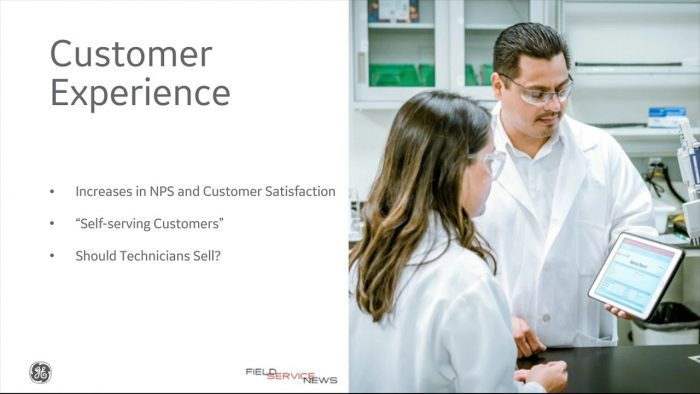It was my honour to host the inaugural European Field Service Awards recently. This was an event that was hosted, to a degree, because we knew we had to bring the industry together again in person – to trade stories from the last two years of how we...
ARCHIVE FOR THE ‘kieran-notter’ CATEGORY
Dec 16, 2021 • Features • Kieran Notter
It was my honour to host the inaugural European Field Service Awards recently. This was an event that was hosted, to a degree, because we knew we had to bring the industry together again in person – to trade stories from the last two years of how we all adapted during these challenging times. It was an opportunity to celebrate the excellence of an industry that stood so tall in the face of adversity.
It was a fantastic event that saw solution providers and industry leaders come together. We all focused on the excellence and innovation that had been on show in our sector, both in terms of technology and strategic service thinking.
As host, I also took the opportunity to say farewell to a good friend to many in that room and someone who was universally respected by all those in attendance. Sadly, Kieran Notter of ServiceMax and, prior to that, Pitney Bowes, unexpectedly passed away earlier this year.
It took me, as it did all of us, by complete surprise. It was a tragic accident that robbed the world of bright light at a time when we were just moving out of the darkness. I’ve been trying to write this article pretty much ever since, but the words never quite felt right. To a degree, I, as are many are still in shock at Kieran’s passing.
However, given the platform of the Awards, I was able to ask those in attendance to share a moment of reflection for Kieran. As I think Kieran would have preferred, I asked for a moment of applause rather than silence. I wanted to celebrate his life rather than mourn our loss. It is a fitting tribute to how well-liked and respected Kieran was that the whole room, colleagues, peers and competitors alike stood proudly to join me in this fairly impromptu request. Those who knew him well and had the privilege of working alongside him stood shoulder to shoulder with those who often been on the other side of the debate stage working in competition to Kieran – and all had nothing but warmth, respect and admiration in their faces.
For me, I had the opportunity to interview Kieran on several occasions, both in a closed-door environment for various productions we had worked together on across the years and in public on stage at various events across the world.
From a professional perspective, Kieran had two distinguishing facets that came to the fore in such situations. Firstly, his wealth of experience prior to joining ServiceMax allowed him to speak not only with authority but with an earnestness that was deeply grounded in having experienced the role of the service leader hands on.
"There was a deep well of experience that Kieran drew on from his career that he continually supplemented with further learning and reading..."
In short, there was a deep well of experience that Kieran drew on from his career that he continually supplemented with further learning and reading.
This is perhaps the other thing that always leapt out to me about Kieran; for him, the ideas of continuous improvement weren’t just a concept to be applied in the operations environment. It was something you could see he applied to his own development and expected of those around him. Kieran was never afraid to push past the status quo in search of a better version of the truth, yet he was also a massive advocate of ensuring that each layer of a problem is fully understood before moving on.
Indeed, the most recent work Kieran and I worked together on is soon to be published - a research study that is the exact epitome of what it is like to work alongside him. During the planning stage, Kieran, Sumair Dutta and I worked closely together to define the shape of the study, the parameters and outline the questions. The process had more friction than is often the case in these situations, as one might expect, with three of the world’s most recognised industry commentators and leaders all having a distinct vision of where the study should go.
The planning process was longer than usual; there were more iterations of the framework, but to be clear, none of us saw that friction as a negative process. We all had the respect and trust in each other to test our respective positions, and only the most robust ideas remained within the final study. The result is one of the most comprehensive research projects we have completed to date. With the initial paper almost ready for release, I think it will be a fitting testament to Kieran and his input to the industry.
"The prospect of hours alone with anyone in a car can be daunting, but such was the depth of Kieran’s various interests and his ability to speak passionately about them that the time flew by..."
However, Kieran was about far more than just his job, and during our many joint appearances at various events, I also had the pleasure of getting to know him personally. I remember Kieran giving me a lift across Sweden one time because we had both booked our return flights from the wrong airport, which was hours away from where we were.
The prospect of hours alone with anyone in a car can be daunting, but such was the depth of Kieran’s various interests and his ability to speak passionately about them that the time flew by.
We talked rugby - Kieran was a hugely important part of Cobham RFC and chairman of their minis – I occasionally coach and volunteer with Ealing minis for whom my son plays.
We talked Land Rovers – my dream has always been to own an early 90s Defender; Kieran was a passionate Defender expert, having owned a number over the years (hence the banner image for this article - I like to think he would approve)
And most importantly, and for the greatest amount of time, we talked family.
With about a decade and a bit between us, mine is a younger family than Kieran’s (my wife and I had our third child only a few weeks ago). However, if I can speak with half the joy, pride and satisfaction that Kieran continuously had in his voice when he talked about his own family, I will be immeasurably happy.
His family meant the world to him, and my deepest and most heartfelt sympathies go out to them on their loss.
I would politely encourage all those who spent time with Kieran to put their thoughts and memories of him in the comments section below so we can capture a note of remembrance for his family from our industry.
Mar 16, 2018 • video • Features • Future of FIeld Service • Kieran Notter • Millenialls • research • GE Digital • IoT • servicemax
Kris Oldland, Editor-in-Chief, Field Service News and Kieran Notter, Director, Global Customer Transformation, ServiceMax from GE Digital explore the findings of an exclusive independent research conducted by Field Service News and sponsored by...
Kris Oldland, Editor-in-Chief, Field Service News and Kieran Notter, Director, Global Customer Transformation, ServiceMax from GE Digital explore the findings of an exclusive independent research conducted by Field Service News and sponsored by ServiceMAx from GE Digital.
In this second excerpt from the full one-hour long webcast, Oldland and Notter discuss both what the must-have skills of the field service engineer are likely to be in the not too distant future taking into account the impact of industry mega-trends such as servitization, digitalisation and an incoming army of millennials.
Want to know more? The full webcast PLUS an exclusive report based on the findings of this research is available for Field Service News subscribers.
If you are a field service practitioner you may qualify for a complimentary 'industry practitioner' subscription. Click here to apply now!
Be social and share
Mar 06, 2018 • video • Features • AGeing Workforce • AR • Artificial intelligence • Future of FIeld Service • Kieran Notter • research • Research • drones • IoT • servicemax
Kris Oldland, Editor-in-Chief, Field Service News and Kieran Notter, Director, Global Customer Transformation, ServiceMax from GE Digital explore the findings of an exclusive independent research conducted by Field Service News and sponsored by...
Kris Oldland, Editor-in-Chief, Field Service News and Kieran Notter, Director, Global Customer Transformation, ServiceMax from GE Digital explore the findings of an exclusive independent research conducted by Field Service News and sponsored by ServiceMax from GE Digital.
In this excerpt from the full one-hour long webcast, Oldland and Notter discuss both the challenges and opportunities of an ageing workforce within the field service sector and assess whether there is any substance to fears that we are facing an ageing workforce crisis.
Want to know more? The full webcast PLUS an exclusive report based on the findings of this research is available for Field Service News subscribers.
If you are a field service practitioner you may qualify for a complimentary 'industry practitioner' subscription. Click here to apply now!
Be social and share
May 09, 2017 • Features • Inventory Management • Kieran Notter • Product Lifecycle • Internet of Things • IoT • servicemax • Servitization • Parts Pricing and Logistics
Kieran Notter, Director, Global Customer Transformation, ServiceMax from GE Digital, takes a fresh look at some perennial problems...
Kieran Notter, Director, Global Customer Transformation, ServiceMax from GE Digital, takes a fresh look at some perennial problems...
Field service management hit the headlines in 2016 as automation, the Internet of Things and servitization reshaped the way we service and maintain capital assets.
These trends have now trickled down to the supply chain, providing a fresh approach to age old headaches. In this article, we look at five areas of friction in the supply chain and how combining field service management with assets is solving them.
The Inventory Tug of War
CFOs will always push for lower inventory levels to free up cash flow and reduce the risk of obsolescence. Yet Service Directors want higher inventory to increase First-Time Fix rates, reduce internal costs, improve productivity and raise customer satisfaction.
The supply chain is between a rock and a hard place trying to balance between two opposing arguments. So what’s the solution? In a word, knowledge.
The supply chain is between a rock and a hard place trying to balance between two opposing arguments. So what’s the solution? In a word, knowledge.
Expensive, Unplanned Freight Costs
Knowing the frequency of parts that fail, and the correct intervals for preventative maintenance visits reduces freight costs with fewer ‘emergency’ shipments. However, the biggest saving here is actually in reducing the parcel count itself. If you know what parts you are going to need and when, you can consolidate shipments, sending them direct to the technician in advance.
At a basic level, just knowing where your assets are means you can position the inventory in more strategic locations to reduce costs and increase availability.
Product Lifecycle – The Delayed Curve
A supply chain is expected to cover the assets through their lifecycle. However, if you cannot see if the install base is growing or shrinking, you can’t align inventory accordingly.
That means it’s on a delayed curve which will either result in back orders for new product ranges as the planning tries to catch up or obsolete stock for products as they come to the end of their lifecycle, and usage slows down as planning has not reacted quickly enough.
Addressing this issue also means you get insight into the true profitability of a contract or product.
Likewise, knowing the top 20 required shipments rather than just focusing on the 200 makes a huge difference to how a supply chain can react and prioritise their efforts and resources. This also gives a much more focused supply to the field service organisation and the customers with the most need.
Back Orders After The Fault Is Fixed
When parts are ordered direct to the fault on the machine, a small change in process and practice can pay huge dividend – cancel back orders once the fault has been fixed. This may not work for all businesses but it will work for many.
In most cases, back orders are left for the supply chain to fulfil, even though the technician has fixed the issue with a borrowed unit from a colleague or fixing the part rather than the assembly ordered. If the original back order is left, the other technician who lent the part is now second in line to get it returned, which has a knock-on effect with a ‘not required’ demand outweighing a potential ‘urgent’ order.
Also, if the original back order is shipped to the customer and the customer’s machine is up and running, then parts are often lost. One company who introduced this practice (less customer fit parts) reduced their back orders by 52%.
IoT (Internet of Things) – The Holy Grail of Condition-Based Service
Many companies are now firmly into the IoT realm and benefitting from the data that is being provided.
From smart sensors telling them what parts need replacement before an issue arises to optimum intervals between preventative maintenance.
Using this voice of the product alongside customer demand means you can plan your inventory to not only be available before a fault arises, but also plan the consumables and after sales items to a level that has not been seen before.
This moves you into the servitization market with confidence and a predictable profit margin.
Without asset knowledge, you are essentially working as a ‘demand’ chain and within the limitations of technicians’ ad hoc tasks to manage any intelligent levels of inventory at your locations.
Without asset knowledge, you are essentially working as a ‘demand’ chain and within the limitations of technicians’ ad hoc tasks to manage any intelligent levels of inventory at your locations.
You will always be behind the curve.
Some companies with high volume and low SKU’s can manage with this model, but all businesses will benefit from more real time data and the ability to not just pre-empt future requirements, but act on them.












 Field Service News is published by 1927 Media Ltd, an independent publisher whose sole focus is on the field service sector. As such our entire resources are focused on helping drive the field service sector forwards and aiming to best serve our industry through honest, incisive and innovative media coverage of the global field service sector.
Field Service News is published by 1927 Media Ltd, an independent publisher whose sole focus is on the field service sector. As such our entire resources are focused on helping drive the field service sector forwards and aiming to best serve our industry through honest, incisive and innovative media coverage of the global field service sector.
Leave a Reply